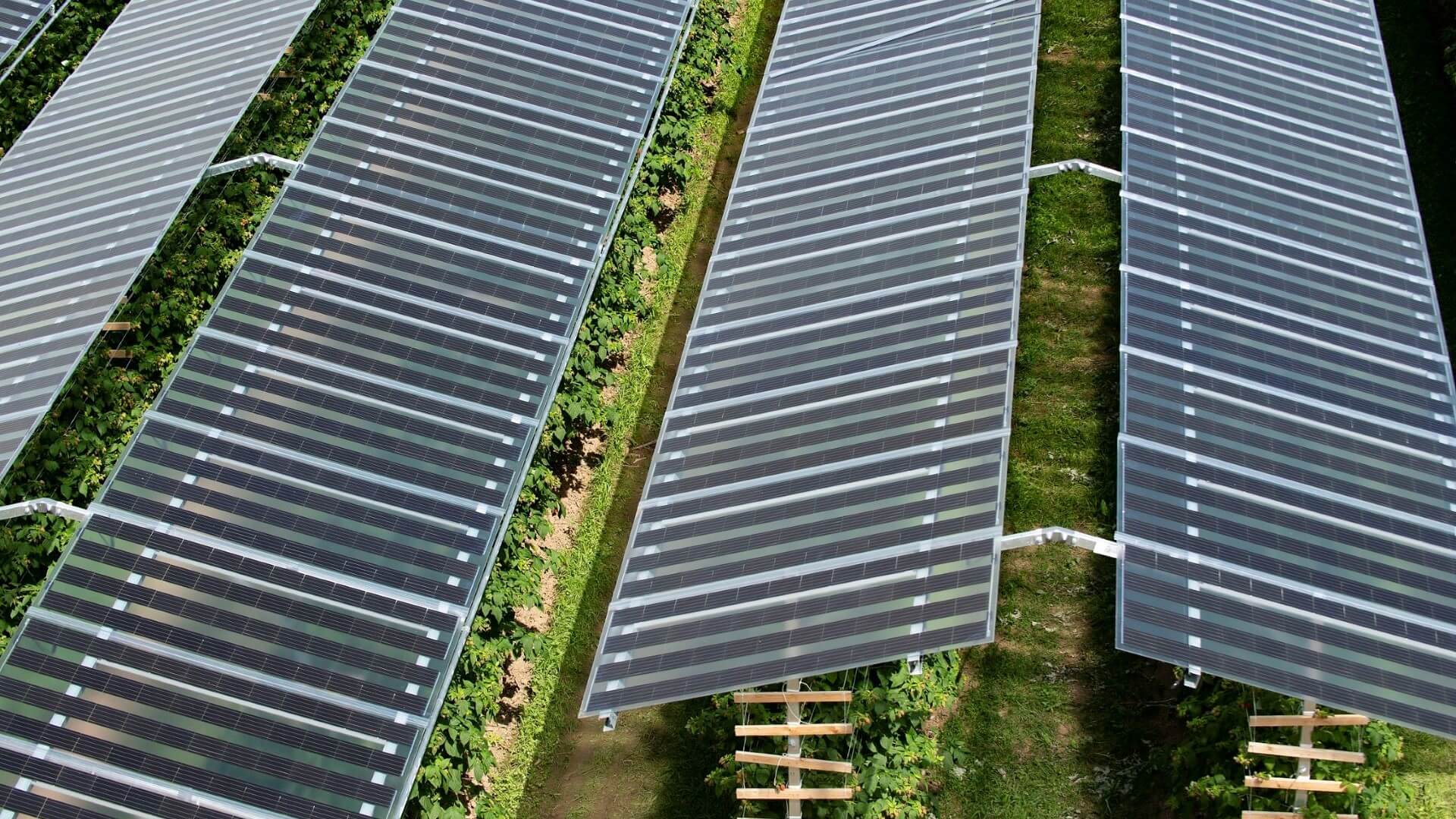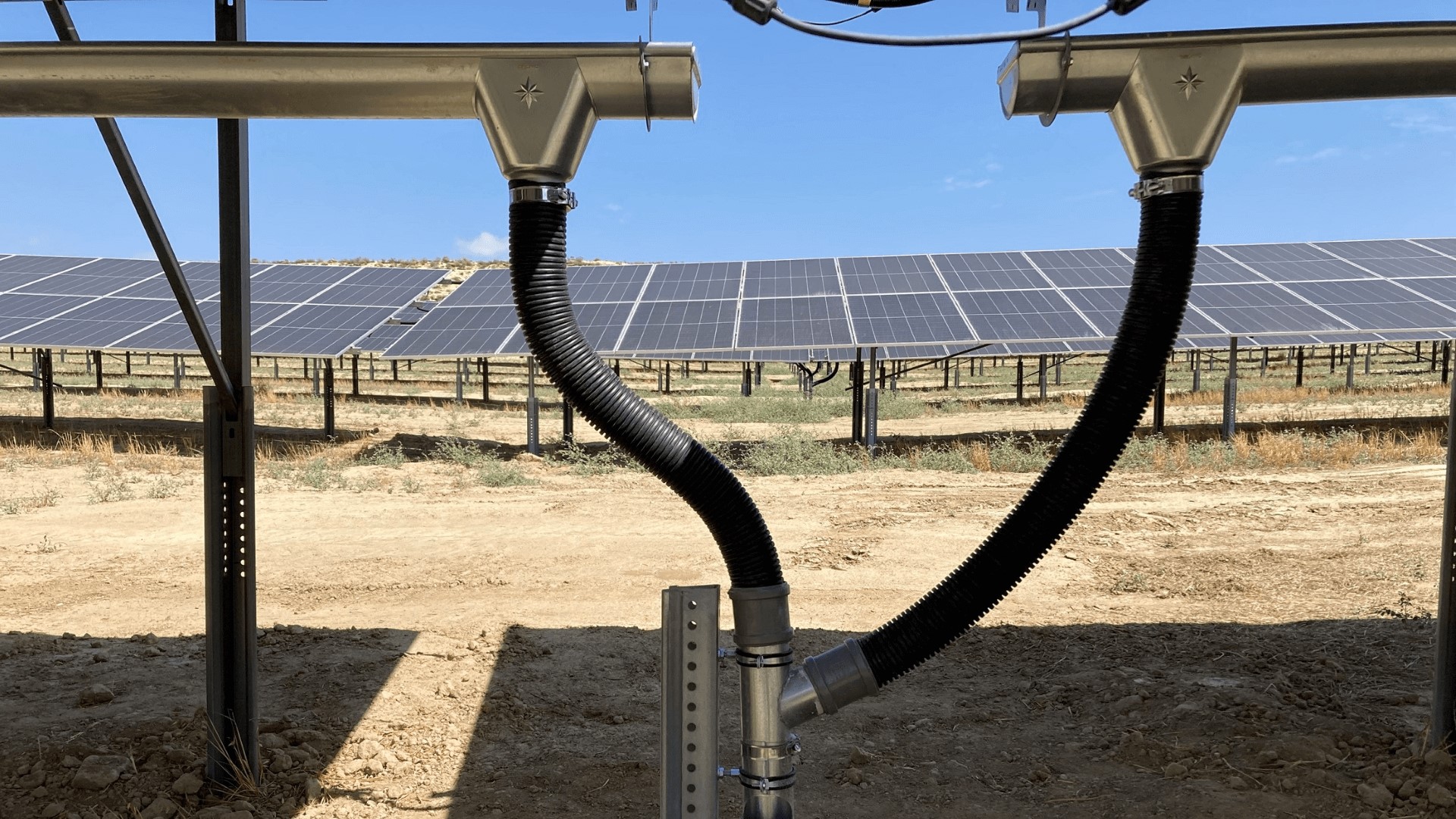UPDATED 1 Sept: The EI library in London is temporarily closed to the public, as a precautionary measure in light of the ongoing COVID-19 situation. The Knowledge Service will still be answering email queries via email , or via live chats during working hours (09:15-17:00 GMT). Our e-library is always open for members here: eLibrary , for full-text access to over 200 e-books and millions of articles. Thank you for your patience.
New Energy World™
New Energy World™ embraces the whole energy industry as it connects and converges to address the decarbonisation challenge. It covers progress being made across the industry, from the dynamics under way to reduce emissions in oil and gas, through improvements to the efficiency of energy conversion and use, to cutting-edge initiatives in renewable and low-carbon technologies.
Harvesting among solar panels: can agrivoltaics help Europe meet green targets?
31/1/2024
8 min read
Feature
In the conflict between land use for food production versus green energy generation, new technology promises to eradicate the either-or-question: agrivoltaics. The European Union (EU) is keen to support the integration of solar panels into farming as a way to meet its renewable energy targets, but energy journalist Karolin Schaps finds hurdles remain along the way.
On the back of the wish to wean itself off Russian energy imports, the EU in 2022 sharpened its solar power capacity goal, wanting to install 720 GW by 2030. This threefold increase from installed capacity in 2022 presents a huge challenge to the European energy sector as developers struggle to gain access to land, project permitting is slow and local opposition to large ground-mounted solar farms is on the rise.
Fresh hopes for meeting the EU’s solar targets now rest on the shoulders of Europe’s farmers as the potential for combining solar farm development with agricultural activity is proving enormous. Using only 1% of the EU’s utilised agricultural area for so-called agrivoltaic projects could result in as much as 944 GW of installed solar capacity, according to the EU’s Joint Research Centre. This would firmly beat the bloc’s 2030 target and deliver renewable energy capacity without eating up valuable fertile land.
‘The industry is ready to take off. We have everything we need: the research, the results, the technology. It comes down to a lot of political will and interest in scaling up renewable energy,’ says Lina Dubina, Policy Adviser for Sustainability at Brussels-based trade association SolarPower Europe.
While its potential is clear, only a handful of EU member states have up until now put regulation and incentives in place that have stimulated the development of agrivoltaic projects, including Italy, Germany and France. Solar panel-covered vineyards, barley harvesters ploughing in between rows of PV modules, and cows grazing next to vertically placed solar structures are increasingly common sights in these countries that are some of the EU’s largest agricultural producers.
Different geographies
Agrivoltaic projects vary greatly in application as different geographies, climates and agricultural products require different solutions. However, many successful agrivoltaic projects have proven not only positive in their socio-economic benefit in utilising agricultural land for dual purposes, they have also brought value to agricultural cultivation.
For example, in France, PV panels placed above grain crops have protected seedlings during times of frost. Agrivoltaic installations in drought-prone Spain have built-in rainwater collection facilities, and in the Netherlands, solar modules covering raspberry plants act as protection from wind and excess sunshine, replacing unsustainable plastic foil. Solar panels can also prevent wind erosion, reduce irrigation demand and optimise irradiation for crops using solar systems that track the sunlight.

Dutch raspberry agri-PV project by BayWa re
Photo: BayWa re
‘Regions that benefit most from agri-PV in Europe are often the ones that are most exposed to climate change, like Spain or the south of France,’ says Alice Lefort, Product Manager for agri-PV at renewable energy company BayWa re. ‘Agri-PV is certainly no threat for the farmers, but more a solution to the threats posed by climate change. We’re part of the multi-functional solution.’
To German farmer Thomas Schmid, installing a 2.5 km² agri-PV system above a field where he cultivates wheat, grass clover, potatoes and celery has been successful at showcasing the compatibility of green electricity and food production. The pilot project near Lake Constance in southern Germany boasts a six-metre-high solar PV frame allowing harvesting machinery to easily navigate below the panels. Bifacial modules are set far enough apart to ensure that plants receive at least 60% of sunlight necessary for photosynthesis.
‘For us farmers, unfortunately, the challenge is that electricity generation is 10 times as lucrative as food production. Thus, from our point of view, we need regulation assuring that generation of electricity is compatible with food production. And that’s what we want to prove,’ comments Schmid, farmer at Hofgemeinschaft Heggelbach.
Germany has put specific agrivoltaic subsidies in place that have helped around 14 MW of agri-PV projects come to life. By 2025, German installed capacity could reach as much as 1 GW, according to the German energy agency Deutsche Energie-Agentur.
‘For us farmers, unfortunately, the challenge is that electricity generation is 10 times as lucrative as food production. Thus, from our point of view, we need regulation assuring that generation of electricity is compatible with food production.’ – Thomas Schmid, German farmer, Hofgemeinschaft Heggelbach
Growth potential
In its EU Solar Energy Strategy, the European Commission acknowledged the large potential contribution of agrivoltaic projects to reach the bloc’s solar power ambitions. It has urged member states to consider incentives for agrivoltaic projects when designing their national frameworks under the EU’s Common Agricultural Policy (CAP) and their support schemes for solar energy.
However, uncertainty around the definition of agrivoltaic projects under national regulation has been one of the main hurdles standing in the way of their further roll-out in other EU countries. To EU farmers, subsidies received under the CAP are the bread and butter of their agricultural activities and anything threatening these payouts is seen as unfeasible.
In Bulgaria, for example, agricultural land loses its classification once an agrivoltaic project is built, and a definition as a different type of land zone usually means higher taxes.
SolarPower Europe is currently working on formulating an EU-wide harmonised definition to help get projects off the ground. ‘One of the bottlenecks we see is that there’s no specific guidelines for other member states on how to start off. We hear from members that an EU-wide approach would help,’ notes Dubina.
Some project developers are dealing with the difference in definitions, or lack thereof, by collaborating on projects within cross-country working groups. Norwegian renewable energy company Statkraft, for example, has created one such internal group which meets regularly to exchange lessons learnt and new concepts that have been tried. The company is developing agrivoltaic projects in Italy, the Netherlands and Spain, and has benefitted from applying certain innovations that have worked in one country on a project in a different country.
‘Italy is very clear on what kinds of crops will need to grow under or next to the panels in order for a project to be considered agri-PV. In the Netherlands, this remains an open question. We need some clarity from the government on a definition,’ says Niels van der Linden, Statkraft’s Country Manager for the Netherlands.
Need for definition
Implementing a set definition will also provide a basis for building subsidy schemes that specifically incentivise agrivoltaic projects. Due to higher material costs, agrivoltaic projects are typically more expensive than standard ground-mounted PV installations. The University of Wageningen in the Netherlands compared the investment costs per hectare of traditional and multi-functional solar systems at a Dutch agrivoltaic fruit farming site. It concluded that a system using semi-transparent panels covering the fruit plants cost €0.75–0.9/W peak, while a standard monofunctional solar park on the same site cost €0.45–0.6/W peak.
What also adds to costs is the tailor-made nature of each agrivoltaic design. Whereas projects in southern Europe will need solutions to protect against extreme temperatures and drought, installations in northern Europe will have to withstand harsh winter conditions.
Germany’s BayWa re, for example, has developed six different specifications for agrivoltaic projects which it applies to its projects across Germany, the Netherlands, France, Italy and Spain, and which it wants to roll out in the US and Asia. These include grazing-PV for sheep and chickens, fruit-PV for berries and stone fruit, or biodiversity-PV for pollinator plants.

Spanish agri-PV project with water management by BayWa re
Photo: BayWa re
Much work goes into finding the ideal link between agricultural products and solar panel installations. Italy’s Enel Green Power, for example, carries out in-depth site analysis of soil composition and site orography (physical geography) to establish which plants and/or crops are best suited to each project. At its 170 MW agrivoltaic project at Piani della Marina, the company identified local crops with stronger-than-normal sunlight diffusion that is expected to result in higher power production from the solar panels.
The additional investment costs needed for agrivoltaic projects make it important that these types of systems don’t have to compete with standard solar PV installations in subsidy tenders, because they would almost always lose out on price.
‘We need the right legal framework from the governments to implement the projects. If we don’t have support from the states, it becomes harder to develop such a solution since we have to level higher capex, opex and levelised costs of energy,’ explains BayWa re’s Lefort.
Another obstacle which has held back a more explosive roll-out of agrivoltaics in Europe is farmers’ attitudes towards solar projects and their willingness to participate in pilot projects. Although many farmers have installed solar panels on agricultural property rooftops or even directly on land, integrating panels into their agricultural activities is a step too far for some.
‘We receive mixed enthusiasm from farmers because they are really uncertain about the impact on agricultural production. What they see is a sub-optimal solar farm because they would earn more money if they built standard ground-mounted solar panels per hectare,’ says Daan van Vulpen, Renewable Energy Developer at European Energy in the Netherlands. The Danish company is involved in a research-based agrivoltaic project at Flakkebjerg in Denmark and is in the early stages of developing agrivoltaic projects in the Netherlands.
In order to lock in direct benefits for the farmer, some developers have signed partnership deals that allow sharing of revenues from the green power sold. ‘Our AgriPV model envisages a partnership agreement with the farmer which creates a de facto mutual bond between PV park energy production and agricultural activity lasting for the whole plant lifetime, promoting shared value creation,’ concludes an Enel Green Power spokesperson.
